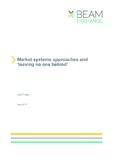| dc.contributor.author | Thorpe, Jodie | |
| dc.coverage.spatial | Ethiopia | en |
| dc.coverage.spatial | Bangladesh | en |
| dc.date.accessioned | 2020-09-08T09:15:27Z | |
| dc.date.available | 2020-09-08T09:15:27Z | |
| dc.date.issued | 2017-06-01 | |
| dc.identifier.citation | Thorpe, J. (2017) Market Systems Approaches and ‘Leaving No One Behind’, London: The Beam Exchange | en |
| dc.identifier.uri | https://opendocs.ids.ac.uk/opendocs/handle/20.500.12413/15616 | |
| dc.description.abstract | Substantial progress has been achieved internationally on reducing poverty since the launch of the Millennium Development Goals over 15 years ago. Despite these achievements, inequality is growing and extreme poverty remains stubbornly high. In response, the 2015 Sustainable Development Goals have set out a clear and explicit commitment to ‘leave no one behind’.
The question is – what role can market systems approaches play in reaching beyond relatively better-off groups to engage and benefit those in the bottom ten per cent — groups excluded socially due to gender, caste, ethnicity or disability status, for example? Can these approaches bring these groups within thriving market systems, reducing poverty and contributing to development at scale? Or do they risk leaving them further behind?
This think piece offers a structured analysis of how market systems approaches, which work through market actors and by facilitating rather than directly delivering solutions, can support inclusion. It also recognises some difficult challenges which limit what these approaches can
be expected to deliver on their own. It builds on earlier work commissioned by the Rockefeller Foundation (Thorpe, Mathie & Ghore, 2017), and draws heavily on the learning and experiences of three market systems programmes that have explicitly sought to reach highly marginalised groups. These are: Graduation with Resilience to Achieve Sustainable Development (GRAD), targeting 65,000 chronically food insecure households in Ethiopia; Pastoralist Resilience Improvement through Market Expansion (PRIME), which seeks to ensure accessibility for people with disability within its programmes; and Samriddhi in Bangladesh, which includes extremely poor households amongst the target population, with strong women’s empowerment goals. The analysis has been further enriched through discussion with 15 market systems practitioners engaged in similar programmes.
The paper starts by exploring who the extremely marginalised are, what we know about how they engage in markets, and the potential for market-based approaches to be more inclusive. It then presents the experiences from GRAD, PRIME and Samriddhi, and draws lessons from these experiences and those of other practitioners for reaching highly marginalised people through a market systems approach. | en |
| dc.language.iso | en | en |
| dc.publisher | The BEAM Exchange | en |
| dc.rights.uri | http://creativecommons.org/licenses/by/4.0/ | en |
| dc.subject | Economic Development | en |
| dc.title | Market Systems Approaches and ‘Leaving No One Behind’ | en |
| dc.type | Other | en |
| dc.rights.holder | The BEAM Exchange | en |
| dc.identifier.externaluri | https://beamexchange.org/uploads/filer_public/07/9e/079e9f44-82f0-44b4-94b4-8feffc8bdafd/msa_leavingnoonebehind.pdf | en |
| dc.identifier.team | Business, Markets and the State | en |
| rioxxterms.funder | Default funder | en |
| rioxxterms.identifier.project | Default project | en |
| rioxxterms.version | VoR | en |
| rioxxterms.funder.project | 9ce4e4dc-26e9-4d78-96e9-15e4dcac0642 | en |


